Background
After months of internal tensions in East Pakistan (now Bangladesh) leading up to the 1971 Bangladesh genocide and a clampdown on Bengali nationalists, many independence fighters had organised themselves into a guerilla army. Called the Mukti Bahini, the rebels were aided by India in their struggle by supply of constant arms training as well as serving Indian Army officers who fought alongside Mukti Bahini. [3] [4] After initial success over Pakistani troops, there had been some relative calm in the region, and further Indian assistance was sought to turn the tide. Economically burdened by nearly 10 million Bangladeshi refugees, [5] [6] [7] India thus started to involve itself deeper into the conflict brewing in the east and stationed its troops near the border. [8]
The Boyra salient, in the north-western East Pakistan, consisted of Garibpur and was at an important crossroads for both nations. Its control was thus vital, as it included a highway to Jessore from India.
On 21 November, the 14 Punjab Battalion, supported by PT-76 tanks from 45 Cavalry and the Mukti Bahini, moved in to capture the areas around Garibpur inside the Pakistani territory. The move was supposed to be a surprise, but a skirmish with patrol troops of both armies the previous day had caused Pakistan to be alerted to the impending attack. Pakistan immediately retaliated with its infantry battalion supported by 3rd Independent Armoured Squadron, equipped with M24 Chaffee light tanks was launched. [9] Retaining the infantry and the recoilless rifles in a defensive position, the tanks were sent forward to ambush the oncoming Pakistani charge. In the next couple of hours, Indian troops resisted the Pakistani attack since Pakistan could not pinpoint the source of attacks because of poor visibility by fog. Undeterred, Pakistan tanks and infantry were thrown into an offensive against Indian defensive positions in a frontal assault. [1] The resulting battle is now famous as the Battle of Garibpur.
As Pakistani troops were unable to dislodge entrenched enemy, the Mitro Bahini and the Indian Army, the Pakistani Army called in close air support. [1] [10] The Pakistani Air Force Contingent in Dhaka responded by launching several sorties of Canadair Sabre Mk6s from the morning of 22 November 1971, which set the stage for the Battle of Boyra. [10]
Order of Battle
The Pakistan Air Force unit involved was No 14. Squadron Tail-choppers, [11] which had on strength 16 Canadair Sabre Mk6s. [12] They were the Canadair-built versions of the F-86 Sabre that were upgraded with AIM-9 Sidewinder missiles and powered by the more powerful Avro Canada Orenda engine. The Sabres were smuggled into Pakistan through a clandestine deal that was organised between West Germany and Iran [13] [14] The Squadron was commanded by Flight Lieutenant Parvaiz Mehdi Qureshi, who later rose to become the Chief of the Air Force, a role in which he was famous for his forthright and straight-faced dealings where he looked after the interests of the PAF. [15]
The reason for the relatively-junior Flight Lieutenant Qureshi being appointed to command a squadron, which is usually commanded by a squadron leader, is unknown. However, it was common for Bengalis in the Pakistan Armed Forces to defect and to join the Mukti Bahini or to be grounded or removed from positions of authority during the war because of suspected loyalty [8] and so that was a likely reason.
The Indian Air Force unit involved was No. 22 Squadron IAF Swifts and was equipped with the diminutive Folland Gnat. The squadron was based in Kalaikunda Air Force Station and tasked with the air defence of the Calcutta Sector. A detachment was stationed at Dum Dum Airfield in Calcutta. The unit was under the command of Wing Commander BS Sikand, who later rose to the rank of air marshal.
Although the Canadair Sabre Mk 6 was widely regarded as the best dogfighter of its era, [16] tactics called for Gnats taking on the Sabres in the vertical arena, where the Sabres were at a disadvantage. Moreover, because the Gnat was lightweight and compact in shape, visibility was poor, especially at the low levels at which most of the dogfights took place. [17]
Battle
The PAF aircraft were providing support the Pakistan Army ground units near the border area in Garibpur. The first of four Sabres were picked up in the Jessore area on Indian radar at 0811 hours. No.22 Squadron scrambled four Gnats from Dum Dum. A second raid by the Pakistanis followed at 1028 hours. An interception again could not be carried out in time, and the Sabres escaped to safety.
At around 1448 hours, the radar picked up the three Sabres as they pulled up in a north-westerly direction to about 2,000 ft (610 m) above ground level. Within a minute, the ORP at Dum Dum was scrambled. Four Gnats took off by 1451 hours led by the formation leader, Flight Lieutenant Roy Andrew Massey. Less than three minutes earlier, the Sabres had been detected by the radar. [18]
The fighter controller in the sector was Flying Officer KB Bagchi, who vectored the Gnats to the Sabres and directed the interception. The Sabres had already carried out several attack runs during the eight minutes that it took the Gnats to reach the Boyra Salient and were starting to start another dive. They were at about 1,800 feet (550 m) altitude and were diving down to 500 feet (150 m) in an attack run.
The four Gnats separated into two sections and dived into the attack to bounce the Sabres. The first section of Gnats was of Massey and Flying Officer SF Soarez as his wingman. The second section consisted of Flight Lieutenant M A Ganapathy and Flying Officer D Lazarus. As the Gnats dived in, a section of two Sabres pulled out of the attack and placed themselves in an awkward position, just in front of Ganapathy and Lazarus. Both pilots opened fire with 30 mm autocannon fire, and both the Sabres were badly damaged. Ganapathy called out on the R/T, the Brevity code for "Murder Murder Murder". The Pakistani pilots (Parvaiz Mehdi Qureshi and Khaleel Ahmed) ejected over Boyra and parachuted down safely but were taken as prisoners-of-war. The wreckage of the abandoned Sabres fell near the village of Bongaon, in India. [18] [19]
Simultaneously, Massey pulled up over Ganapathy and Lazarus to latch onto another Sabre. The Sabre pilot, Wing Commander Chaudhury, in a skilful dogfighting move broke into Massey's attack and forced him to take a high angle-off burst, which missed his target. After manoeuvring back into firing position and taking aim, Massey let off another burst at 700 yards (640 m) and hit him in the port wing. By then, Massey's starboard cannon had stopped firing, but the Sabre streaked back into Pakistani territory and billowed smoke and fire. Massey realised that he was well over East Pakistani airspace in his chase and turned around and regrouped with the rest of his formation, which then proceeded back to base. Early on, it was thought that the badly-damaged Sabre must have crashed soon afterward, but after the war, reports confirmed that Massey's victim, Wing Commander Chaudhury, showing considerable courage, had managed to fly his Sabre back to Tezgaon Airfield, outside Dhaka. Chaudhury claimed that he had shot down one of the Gnats, but Indian officials claimed that no aircraft were lost in the battle. [10] [20]
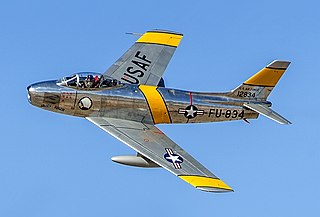
The North American F-86 Sabre, sometimes called the Sabrejet, is a transonic jet fighter aircraft. Produced by North American Aviation, the Sabre is best known as the United States' first swept-wing fighter that could counter the swept-wing Soviet MiG-15 in high-speed dogfights in the skies of the Korean War (1950–1953), fighting some of the earliest jet-to-jet battles in history. Considered one of the best and most important fighter aircraft in that war, the F-86 is also rated highly in comparison with fighters of other eras. Although it was developed in the late 1940s and was outdated by the end of the 1950s, the Sabre proved versatile and adaptable and continued as a front-line fighter in numerous air forces.

The Folland Gnat is a British compact swept-wing subsonic fighter aircraft that was developed and produced by Folland Aircraft. Envisioned as an affordable light fighter in contrast to the rising cost and size of typical combat aircraft, it was procured as a trainer aircraft for the Royal Air Force (RAF) as well as by export customers, who used the Gnat in both combat and training capacities.
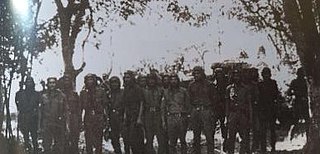
The Battle of Garibpur was fought between the Indian forces and Pakistan for the control of the village of Garibpur, now in Bangladesh. On 20 November 1971, Indian troops of the 14th Battalion of the Punjab Regiment with 14 supporting PT-76 tanks from the 45 Cavalry moved in to capture the areas around Garibpur in Pakistani territory. The battle started by Pakistani troops counterattacking the next day to recapture Garibpur.

Flying Officer Nirmal Jit Singh Sekhon, PVC was an officer of the Indian Air Force. He was posthumously awarded the Param Vir Chakra, India's highest military decoration during war time, in recognition of his lone defence of Srinagar Air Base against a Pakistan Air Force (PAF) air raid during the Indo-Pakistani War of 1971. He is the only member of the Indian Air Force to be honoured with the PVC.
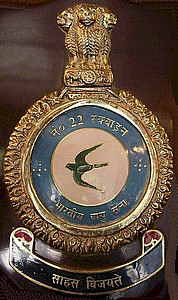
No. 22 Squadron (Swifts) was a CAS unit based out of Hasimara AFS. Along with No. 222 Squadron IAF Tiger Sharks, No. 22 Squadron forms a part of the 16 Wing of the IAF. The squadron operated MiG-27 till December 2017 and the squadron number-plated since then.
The Bangladesh Liberation War started on 26 March 1971 and ended on 16 December 1971. Some of the major events of the war are listed in the timeline below.
East Pakistan Air Operations covers the activity of the Pakistan Air Force (PAF) and Pakistan Army Aviation units in former East Pakistan during the Bangladesh Liberation War. The operations involved the interdiction, air defense, ground support, and logistics missions flown by the Bangladesh Air Force, Indian Air Force, and the Indian Navy Aviation wing in support of the Mukti Bahini and later Indian Army in Bengal.
Operation Chengiz Khan was the code name assigned to the preemptive strikes carried out by the Pakistani Air Force (PAF) on the forward airbases and radar installations of the Indian Air Force (IAF) on the evening of 3 December 1971, and marked the formal initiation of hostilities of the Indo-Pakistani War of 1971. The operation targeted 11 of India's airfields and also included artillery strikes on Indian positions in Kashmir. The targets were the Indian Airbases of Amritsar, Ambala, Agra, Awantipur, Bikaner, Halwara, Jodhpur, Jaisalmer, Pathankot, Bhuj, Srinagar and Uttarlai and air defence radars at Amritsar and Faridkot.
The Indian Air Force was established on 8 October 1932 independently of the army and navy and in a similar format to the British Royal Air Force. It had been a recommendation of the Skeen Committee, which had been tasked to look into demands for the Indianisation of the Indian army. Its first squadron was raised on 1 April 1933.

During the Indo-Pakistani war of 1965, the Indian and Pakistani Air Forces engaged in large-scale aerial combat for the first time. In the air war, which took place in September, both air forces conducted thousands of defensive and offensive sorties over Indian and Pakistani airspace. Both India and Pakistan claimed victory in the air war; Pakistan claimed to have destroyed 104 Indian aircraft and lost 19, and India claimed to have destroyed 73 Pakistani aircraft and lost 35 of its own. The air war ended in a stalemate.
Air Chief Marshal Parvaiz Mehdi QureshiNI(M) HI(M) SI(M) SBt best known as PQ Mehdi, is a retired four-star air officer and former fighter pilot who served as the eighth Chief of Air Staff (CAS) of the Pakistan Air Force from 1997 until his retirement in 2000.
The Indian Army had no standby force ready in 1971 with the specific task of attacking East Pakistan, one of the many reasons why India did not immediately intervene after Pakistan launched Operation Searchlight in March 1971. Indian Army's Eastern Command was tasked with defending the northern and eastern borders and fighting the insurgencies in Nagaland, Mizoram and Naxalites in West Bengal at that time.

The Eastern Command of the Pakistan Army also known as III Corps was a corps-sized military formation headed by a lieutenant-general, who was designated the Commander 3 Corps. After the partition of India by United Kingdom, the Islamic Republic of Pakistan was divided into two territories separated by 1,000 miles (1,600 km). Most of the assets of the Pakistan armed forces were stationed in West Pakistan; the role of the Pakistan armed forces in East Pakistan was to hold that part of the country until the Pakistani forces defeated India in the west. The Pakistan Army created the Eastern Command, with one commander in the rank of Lieutenant General responsible for the command. The armed forces, had drawn up a plan to defend Dhaka by concentrating all their forces along the Dhaka Bowl.

Prior to Bangladesh Liberation War in 1971, India had no plans for large scale military action in East Pakistan. Since the Sino-Indian War of 1962, the primary objective of the Indian Army Eastern Command was the defence of the Indian northern and eastern borders, defending the "Shiliguri Corridor", and on combating insurgencies raging in Mizoram, Nagaland, Manipur and the Naxalites in West Bengal.
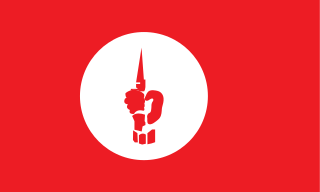
The Mukti Bahini, also known as the Bangladesh Forces, was the guerrilla resistance movement consisting of the Bangladeshi military, paramilitary and civilians during the Bangladesh Liberation War that transformed East Pakistan into Bangladesh in 1971. They were initially called the Mukti Fauj.
Squadron Leader Mandepanda Appachu Ganapathy was a fighter pilot and officer of the Indian Air Force, known for his involvement in the Aerial Battle of Boyra during the Indo-Pakistani War of 1971. He was awarded the Vir Chakra for shooting down a PAF Sabre in the above-mentioned aerial battle
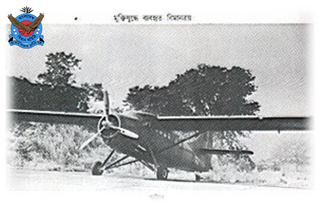
Kilo Flight was the code name for the Mukti Bahini combat aviation formation during the Bangladesh Liberation War in 1971. It consisted of one DHC-3 Otter plane and one Alouette III helicopter, both carrying rocket pods and machine guns for launching hit-and-run attacks on Pakistani targets, and one DC-3 Dakota for logistical missions. 9 Bengali pilots and 58 ex PAF personnel formed the unit under the command of Group Captain A. K. Khandker in September 1971. The aircraft were supplied by Indian Authorities and the formation was led by Squadron Leader Sultan Mahmud under the operational control of IAF base Jorhat. The unit started training in October 1971 at Dimapur in Nagaland, and this unit was the first to launch airstrikes on Pakistani targets in East Pakistan on December 4, 1971, by attacking oil depots at Narayanganj and Chittagong. In total the unit flew 90 sorties and 40 combat missions between December 4 and 16, 1971. After the war, this unit formed the core of the nascent Bangladesh Air Force.

Group Captain Virendera Singh Pathania, VrC, VM, was an Indian Air Force (IAF) fighter pilot reputed for making the first confirmed aerial dogfight kill of independent India when he shot down a Pakistan Air Force (PAF) Sabre Jet with his Folland Gnat on 4 September 1965. For this action, he was awarded the Vir Chakra.
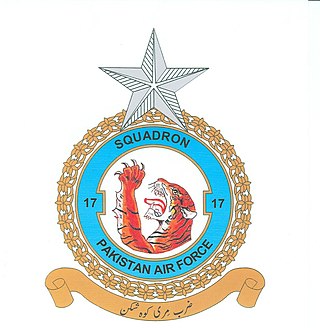
The No. 17 Squadron nicknamed Tigers, is an air superiority squadron of the Pakistan Air Force's Northern Air Command. It is currently deployed at Peshawar Air Base and operates the Chengdu F-7PG aircraft.











